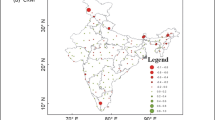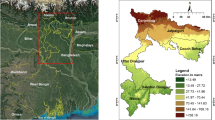Abstract
Daily gridded (1°×1°) temperature data (1969–2005) were used to detect spatial patterns of temporal trends of maximum and minimum temperature (monthly and seasonal), growing degree days (GDDs) over the crop-growing season (kharif, rabi, and zaid) and annual frequencies of temperature extremes over India. The direction and magnitude of trends, at each grid level, were estimated using the Mann–Kendall statistics (α = 0.05) and further assessed at the homogeneous temperature regions using a field significance test (α=0.05). General warming trends were observed over India with considerable variations in direction and magnitude over space and time. The spatial extent and the magnitude of the increasing trends of minimum temperature (0.02–0.04 °C year−1) were found to be higher than that of maximum temperature (0.01–0.02 °C year−1) during winter and pre-monsoon seasons. Significant negative trends of minimum temperature were found over eastern India during the monsoon months. Such trends were also observed for the maximum temperature over northern and eastern parts, particularly in the winter month of January. The general warming patterns also changed the thermal environment of the crop-growing season causing significant increase in GDDs during kharif and rabi seasons across India. The warming climate has also caused significant increase in occurrences of hot extremes such as hot days and hot nights, and significant decrease in cold extremes such as cold days and cold nights.







Similar content being viewed by others
References
Arora M, Goel NK, Singh P (2005) Evaluation of temperature trends over India. Hydrol Sci J 50:81–93
Bhutiyani MR, Kale VS, Pawar NJ (2007) Long-term trends in maximum, minimum and mean annual air temperatures across the northwestern Himalaya during the twentieth century. Clim Chang 85:159–177
Caesar J, Alexandar L, Russell V (2006) Large-scale changes in observed daily maximum and minimum temperatures: creation and analysis of a new gridded data set. J Geophys Res 111:DO5101
Chung YS, Yoon MB (2000) Interpretation of recent temperature and precipitation trends observed in Korea. Theor Appl Climatol 67:171–180
Cramer W, Fischer A (1996) Data requirement for global terrestrial ecosystem modeling. In: Walker B, Steffen W (eds) In global change and terrestrial ecosystems. Cambridge University Press, Cambridge, pp. AQ7 530–AQ7 565
Das PK, Chakraborty A, Seshasai MVR (2013) Spatial analysis of temporal trend of rainfall and rainy days during the Indian summer monsoon season using daily gridded (0.5 × 0.5) rainfall data for the period of 1971–2005. Meteorol Appl. doi:10.1002/met.1361
Dash SK, Mamgain A (2011) Changes in the frequency of different categories of temperature extremes in India. J Appl Meteorol Climatol 50:1842–1858
Director H, Bornn L (2015) Connecting point-level and gridded moments in the analysis of climate data. J Clim 28:3496–3510
Domonkos P, Tar K (2003) Long term changes in observed temperature and precipitation series 1901–1998 from Hungary and their relations to large scale changes. Theor Appl Climatol 75:131–147
Efthymiadis D, Goodess C, Jones P (2011) Trends in Mediterranean gridded temperature extremes and large-scale circulation influences. Nat Hazards Earth Syst Sci 11:2199–2214
Feidas H, Makrogiannis T, Bora-Santa E (2004) Trend analysis of air temperature time series in Greece and their relationship with circulation using surface and satellite data: 1955-2001. Theor Appl Climatol 79:185–208
Hasanean HM (2001) Fluctuations of surface temperature in the eastern Mediterranean. Theor Appl Climatol 68:75–87
Hingane LS, Rupa Kumar K, Murty VR (1985) Long-term trends of surface air temperature in India. Int J Climatol 5:521–528
Hulme M (1994) Validation of large-scale precipitation fields in general circulation models. In: Desbois M, Desalmand F (eds) In Global Precipitation and Climate Change. Springer, Berlin, pp. 387–405
Hulme M, Mitchell J, Ingram W, Lowe J, Johns T, New M, Viner D (1999) Climate change scenarios for global impact studies. Glob Environ Chang 9(supplement 1):S3–S19
IPCC (2013) Summary for policymakers. In: Stocker TF, Qin D, Plattner G-K, Tignor M, Allen SK, Boschung J, Nauels A, Xia Y, Bex V, Midgley PM (eds) In: climate change 2013: the physical science basis. Contribution of working group I to the fifth assessment report of the intergovernmental panel on climate change. Cambridge University Press, Cambridge and New York
Keeling CD, Whorf TP (2001) Atmospheric carbon dioxide record from Mauna Loa, in trends online: a compendium of data on global change, Carbon Dioxide Information Analysis Center, Oak Ridge National Laboratory, at http://cdiac.esd.ornl.gov.
Kendall, MG (1975) Rank correlation methods, 4th edition, Charles Griffin, London, UK.
Kiktev D, Sexton DMH, Alexander L, Folland CK (2003) Comparison of modeled and observed trends in indices of daily climate extremes. J Clim 16:3560–3571
Klein Tank AMG, Konnen GP (2003) Trend in indices of daily temperature and precipitation extremes in Europe, 1946–1999. J Clim 16:3665–3680
Kothawale DR, Munot AA, Krishna Kumar K (2010a) Surface air temperature variability over India during 1901–2007, and its association with ENSO. Clim Res 42:89–104
Kothawale DR, Revadekar JV, Rupa Kumar K (2010b) Recent trends in pre-monsoon daily temperature extremes over India. J Earth Syst Sci 119:51–65
Kothawale DR, Rupa Kumar K (2005) On the recent changes in surface temperature trends over India. Geophys Res Lett 32:L18714. doi:10.1029/2005GL023528.
Kutiel H, Maheras P (1998) Variations in the temperature regime across the Mediterranean during the last century and their relationship with circulation indices. Theor Appl Climatol 61:39–53
Liu B, Xu M, Henderson M, Ye Q, Yiging L (2004) Taking China’s temperature: daily range, warming trend and regional variation, 1955–2000. J Clim 17(22):4453–4462
Livezey RE, Chen WY (1983) Statistical field significance and its determination by Monte Carlo technique. Mon Weather Rev 111:46–59
Mann HB (1945) Non-parametric tests against trend. Econometrica 13:245–259
Morak S, Hegerl G, Christidis N (2013) Detectable changes in the frequency of temperature extremes. J Clim 26:1561–1574
New MG, Hulme M, Jones PD (2000) Representing twentieth century space-time climate variability, part II: development of 1901–96 monthly grids of terrestrial surface climate. J Clim 13:2217–2238
Pal I, Al-Tabbaa A (2010) Long-term changes and variability of monthly extreme temperatures in India. Theor Appl Climatol 100:45–56
Pant GB, Rupa Kumar K (1997) Climates of south Asia (Chichester: John Wiley & Sons) 320 pp. (ISBN 0–471–94948-5).
Piper SC, Stewart EF (1996) A gridded global data set of daily temperature and precipitation for terrestrial biospheric modeling. Glob Biogeochem Cycles 10:752–782
Plummer N, Sainger MJ, Nicholls N, Suppich R, Hennessy KJ, Leigthan RM, Treulin BC, CM P, JM L (1999) Changes in climate extremes over the Australian region and New Zealand during the twentieth century. Clim Chang 42(1):183–202
Pramanik SK, Jagannathan P (1954) Climatic changes in India rainfall. Indian J Meteorol Geophys 4:291–309
Revadekar JV, Kothawale DR, Rupa Kumar K (2009) Role of El Niño/La Niña in temperature extremes over India. Int J Climatol 29:2121–2129
Revadekar JV , Kothawale DR., Patwardhan SK, Pant GB, Rupa Kumar K (2012) About the observed and future changes in temperature extremes over India. Nat Hazards 60(3): 113–1155
Revadekar JV, Hameed S, Collins D, Manton M, Sheikh M, Borgaokar HP, Kothawale DR, Adnan M, Ahmed AU, Ashraf J, Baidya S, Islam N, Jayasinghearachhchi D, Manzoor N, Premalal KHMS, Shreshta ML (2013) Impact of altitude and latitude on changes in temperature extremes over South Asia during 1971-2000. Int J Climatol 33(1):199–209
Krishankumar RKK, GB P (1994) Diurnal asymmetry of surface temperature trends over India. Geophys Res Lett 21:677–680
Schwartz MD, Ahas R, Aasa A (2006) Onset of spring starting earlier across the Northern Hemisphere. Glob Chang Biol 12:343–351
Sen PK (1968) Estimation of regression coefficients based on Kendall’s tau. J Am Stat Assoc 63:1379–1389
Shepard D (1968) A two dimensional interpolation function for irregularly spaced data. Proc. 23rd National Conference. Association for computing machinery, New York. NY, pp. 517–524
Singh N, Sontakke NA (2002) On climatic fluctuations and environmental changes of the Indo-Gangetic plains, India. Clim Chang 52(3):287–313
Srivastava AK, Rajeevan M, Kshirsagar SR (2009) Development of high resolution daily gridded temperature dataset (1969-2005) for the Indian region. Atmos Sci Lett 10:249–254
Srivastava HN, Dewan BN, Dikshit SK, Rao PGS, Singh SS, Rao KR (1992) Decadal trends in climate over India. Mausam 43:7–20
Stafford JM, Wendler G, Curtis J (2000) Temperature and precipitation of Alaska: 50 year trend analysis. Theor Appl Climatol 67:33–44
Tangang FT, Juneng L, Ahmed S (2007) Trend and interannual variability of temperature in Malaysia: 1961–2002. Theor Appl Climatol 89:127–141
Wilks DS (2006) On “Field Significance” and the false discovery rate. J Clim 45:1181–1189
Willmott CJ, Matsuura K (1995) Smart interpolation of annually averaged air temperature in the United States. J Appl Meteorol 34:2577–2586
Yue S, Hashino M (2003) Temperature trends in Japan: 1900–1996. Theor Applied Climatol 75:15–27
Acknowledgments
The India Meteorological Department is duly acknowledged for providing gridded temperature data. The authors are grateful to anonymous reviewers and editor for their valuable suggestions.
Author information
Authors and Affiliations
Corresponding author
Rights and permissions
About this article
Cite this article
Chakraborty, A., Seshasai, M.V.R., Rao, S.V.C.K. et al. Geo-spatial analysis of temporal trends of temperature and its extremes over India using daily gridded (1°×1°) temperature data of 1969–2005. Theor Appl Climatol 130, 133–149 (2017). https://doi.org/10.1007/s00704-016-1869-8
Received:
Accepted:
Published:
Issue Date:
DOI: https://doi.org/10.1007/s00704-016-1869-8




